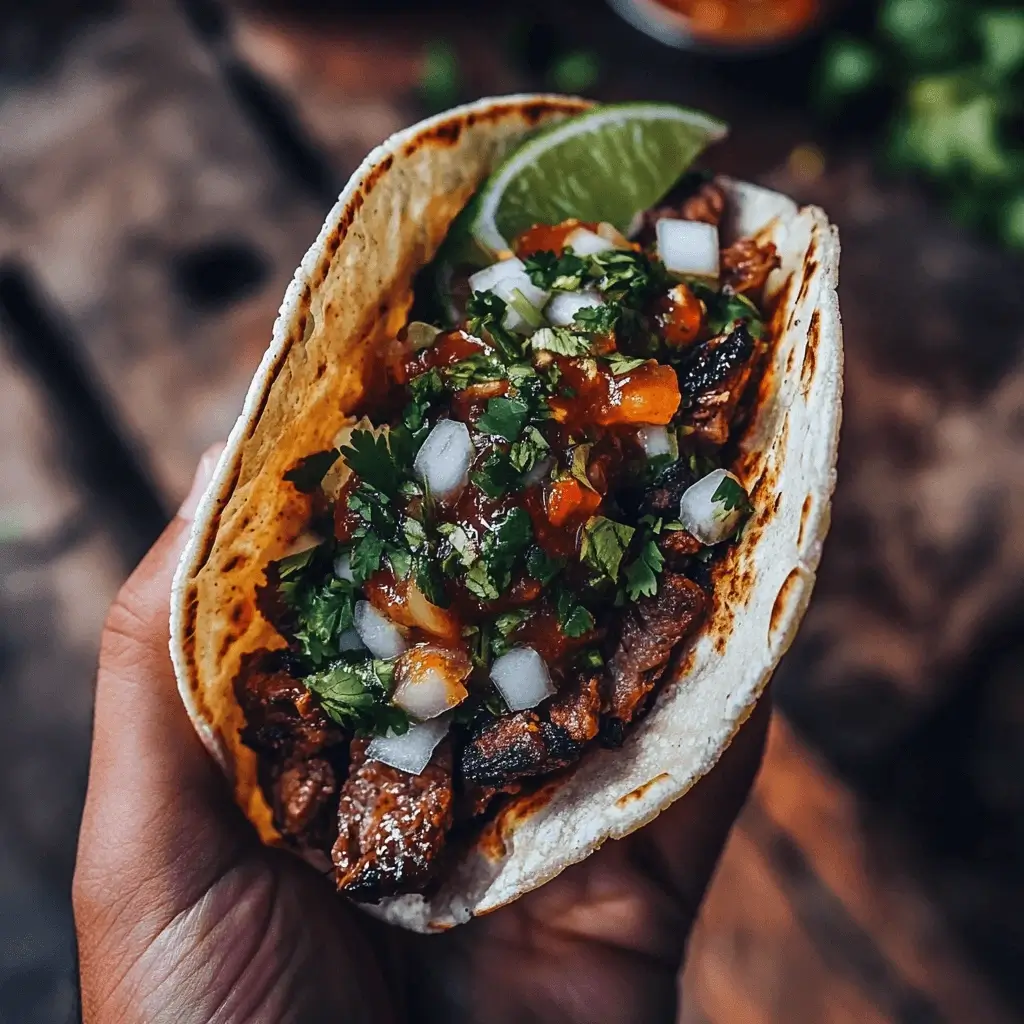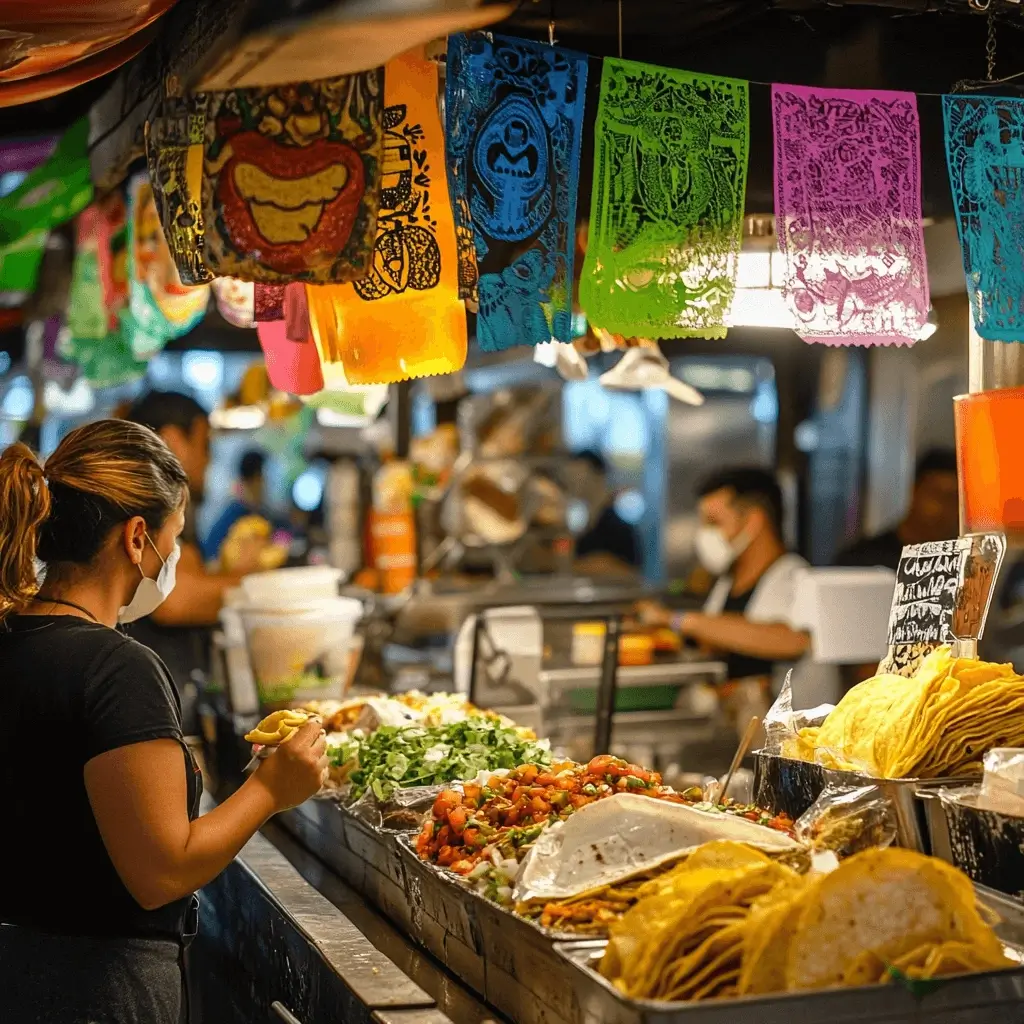Introduction
If you’re a taco lover, chances are you’ve already had your fair share of carne asada, al pastor, and carnitas. But there’s one taco filling that’s often overlooked — even by seasoned foodies — and that’s buche meat. Found sizzling on the griddles of street vendors across Mexico, buche tacos are a hidden gem in the world of Mexican street food. With a rich, savory flavor and a satisfyingly tender texture, buche delivers a culinary experience that’s every bit as bold and unforgettable as the better-known taco meats.
So, what exactly is buche? In simple terms, buche refers to beef stomach, a cut of offal (organ meat) that has been embraced by traditional Mexican cooking for generations. While the idea of eating stomach might raise a few eyebrows among the uninitiated, buche is deeply respected in Mexican culinary culture for its depth of flavor, versatility, and ability to absorb marinades and spices beautifully.
In this post, we’re diving deep into the world of buche tacos — from understanding what this underrated meat is, to learning how it’s prepared, how it compares to other taco fillings like tripas and carnitas, and how you can enjoy it at home or at your local taquería. Whether you’re a taco enthusiast looking to try something new or a home cook curious about working with offal meats, this guide will give you everything you need to know about buche meat and why it deserves a spot in your taco rotation.
What Is Buche Meat?
Buche might not be the first thing you think of when you crave tacos, but it’s one of the most authentic and flavorful cuts used in Mexican street food. Known as beef stomach, buche is a part of the pig that’s been enjoyed for centuries in many world cuisines — not just in Mexico. It’s considered a type of offal, or organ meat, which includes everything from liver to intestines to tongue. In Mexico, these parts of the animal are not just used — they’re celebrated.

A Closer Look at Buche: The Cut and the Culture
In culinary terms, buche is taken from the upper portion of the pig’s stomach, a muscular and layered organ that, when cooked properly, becomes incredibly tender and rich. Unlike muscle meats that can be dry or tough without the right care, buche’s gelatinous texture becomes silky and flavorful when slowly simmered or braised. This makes it perfect for tacos, where texture plays as much a role as taste.
In Mexican culture, using every part of the animal is a tradition rooted in respect for food, economy, and sustainability. Buche, like tripas (intestines) or lengua (tongue), is a staple in taquerías across the country. It’s especially popular in central and southern Mexico, where family-run taco stands have been perfecting their buche recipes for generations.
What Does Buche Taste Like?
If you’re wondering what buche tastes like, the answer might surprise you. It’s not as “offal” or gamey as you might expect. When cleaned and cooked correctly, buche has a mild, savory flavor with a richness that comes from the fat and connective tissue in the stomach. Its texture is soft, slightly chewy, and juicy — imagine something between slow-cooked beef belly and tender calamari.
Unlike cuts like carnitas, which are crispy and fatty, or tripas, which are often deep-fried until crunchy, buche offers a more subtle and comforting mouthfeel. It acts like a sponge for spices and salsas, making it incredibly flavorful when paired with garlic, cumin, oregano, and chili.
Why Buche Is So Underrated
Buche often flies under the radar simply because many people aren’t familiar with it — or are put off by the idea of eating stomach. But those who have tried it (especially in authentic buche tacos) know it’s one of the best-kept secrets of Mexican street food. Its low cost, high flavor potential, and cultural significance make it a true treasure for anyone looking to explore more adventurous taco options.
In a world where nose-to-tail eating is gaining popularity for both ethical and flavor reasons, buche deserves its moment in the spotlight. Once you give it a try, you might just find it becomes your new go-to taco filling.
How to Prepare and Cook Buche Meat
Cooking buche meat might seem intimidating at first — especially if you’ve never worked with offal before — but once you learn the basics, you’ll find that preparing beef stomach is surprisingly straightforward. The key lies in cleaning, boiling, seasoning, and then finishing the meat in a way that brings out its tender texture and rich flavor. Whether you’re planning to make authentic buche tacos at home or just want to understand what goes into them at your local taquería, this section breaks down everything you need to know.

Cleaning and Prepping Buche Properly
The first step in working with buche is ensuring it’s cleaned thoroughly. beef stomach naturally has a strong odor and some grit due to its function in the animal, so proper cleaning is crucial for a pleasant flavor and safe consumption.
Steps to clean buche meat:
- Rinse well under cold running water.
- Soak in vinegar or lemon juice and salt for 15–20 minutes. This helps remove any residual odor and slime.
- Scrub gently with your hands or a clean brush, then rinse again.
- Optional: Some cooks boil it briefly (5–10 minutes) and discard the water to further purify the meat before the main cooking begins.
This step might seem tedious, but it’s essential — and it makes a world of difference in the final flavor of your buche tacos.
Cooking Techniques for Tender, Flavorful Buche
Once your buche is clean, it’s time to cook. Most traditional recipes start by boiling or braising the beef stomach in a flavorful liquid. This breaks down the connective tissue and softens the meat.
Basic buche cooking method:
- Add cleaned buche to a large pot of water.
- Throw in aromatics like onion, garlic, bay leaves, oregano, cumin, and salt.
- Simmer for 1.5 to 2 hours, or until the meat is tender but not falling apart.
Once boiled, the meat can be sliced into bite-sized pieces and used in various ways:
- Griddled on a comal until slightly crispy.
- Lightly pan-fried for a caramelized edge.
- Grilled for a smoky, charred flavor.
This finishing step is often what gives taquería-style buche its signature taste and texture.
Best Seasonings and Marinades for Buche
Buche has a naturally rich and meaty flavor, but it’s also a sponge for spices and marinades. If you want to infuse even more depth into your dish, consider a quick marinade after boiling and before frying.
Popular flavorings include:
- Cumin, paprika, oregano, black pepper
- Chopped garlic and white onion
- A splash of citrus (lime or orange juice)
- Chili powder or guajillo chile paste for a smoky kick
Let it marinate for 15–30 minutes before the final cooking stage to elevate your tacos with bold, layered flavors.
How Long to Cook Buche for Perfect Texture
Timing is everything when it comes to buche. Undercook it, and it’ll be rubbery and tough. Overcook it, and it might fall apart or become too soft.
General rule:
- Simmering time: 90–120 minutes (depending on the thickness of the cut)
- Finishing time: 5–10 minutes on a hot griddle or skillet
You’ll know it’s ready when the pieces are fork-tender, slightly chewy but yielding, with a rich, savory aroma.
Buche Tacos in Mexican Street Food Culture
When it comes to authentic Mexican street food, buche tacos hold a special place that goes beyond just their taste. They are a testament to the rich culinary traditions and resourcefulness that define Mexico’s taco culture. Understanding the cultural context of buche tacos helps you appreciate not only the flavors but also the story behind every bite.

Why Buche Holds Its Own at the Taquería
At any busy taquería in Mexico, you’ll often find buche listed alongside other classic fillings like carnitas, al pastor, and tripas. Buche is cherished for its unique texture and flavor, which adds variety to the taco experience. Taqueros (taco vendors) know that buche’s ability to soak up seasonings and salsa makes it a crowd favorite for those looking to explore beyond typical meat options.
Despite being an offal, buche is anything but “off-putting” in the eyes of taco lovers. In fact, many locals will argue that a good buche taco is a sign of a top-notch taquería because it requires skill and patience to prepare perfectly.
Regional Variations in Buche Preparation
Just like many Mexican dishes, buche tacos aren’t made the same way everywhere. In Mexico City, for example, you’ll often find buche simmered slowly, then finished on a hot griddle to develop a slightly crispy edge. Meanwhile, in parts of Jalisco or Oaxaca, buche might be marinated with regional spices or cooked with smoky chiles, adding a distinct twist.
These regional differences reflect the local ingredients, traditions, and flavor preferences — giving each buche taco its own character. If you travel through Mexico, trying buche tacos from different regions is a delicious way to explore the diversity of Mexican street food.
Toppings and Salsas That Perfectly Complement Buche
One of the best things about buche tacos is how well they pair with a variety of traditional toppings and salsas. Because buche itself has a rich, slightly fatty texture, the bright acidity of fresh toppings balances the flavors perfectly.
Common toppings include:
- Freshly chopped white onion and cilantro — classic, simple, and fresh.
- Salsa verde — tangy and slightly spicy, made from tomatillos.
- Salsa roja — made from red chilies and tomatoes, with a smoky kick.
- Lime wedges — a squeeze of lime adds brightness and cuts through the richness.
- Avocado or guacamole — creamy and cooling against the savory meat.
This combination of textures and flavors is what makes eating buche tacos so satisfying and memorable.
The Role of Buche in Nose-to-Tail Eating Traditions
Buche tacos are also a perfect example of the nose-to-tail eating philosophy, which encourages using every part of the animal to reduce waste and respect the ingredient. In Mexican cooking, organ meats like buche, tripas, and lengua have long been celebrated — not just out of necessity, but because they offer unique flavors and textures that muscle meats can’t match.
This tradition connects food lovers to a deeper appreciation of cooking and eating responsibly, while also opening up a world of new culinary experiences. For adventurous eaters, buche tacos offer both authenticity and sustainability in one delicious package.
Buche tacos are more than just street food—they’re a cultural experience that carries history, tradition, and bold flavors. Next, we’ll explore how buche compares to other popular taco meats and why it’s worth adding to your taco lineup.
Buche vs Other Popular Taco Meats
If you’re new to Mexican tacos or even a seasoned fan, you might wonder how buche stacks up against other popular taco meats like tripas and carnitas. Each brings something unique to the table, from flavor and texture to cooking methods and cultural appeal. Understanding these differences can help you appreciate buche tacos even more and maybe inspire you to try them all!

Buche vs Tripas: Texture and Taste
Both buche and tripas fall under the category of offal, but they come from very different parts of the pig and offer distinct eating experiences. Buche is beef stomach, while tripas are beef intestines.
- Texture: Buche is soft, tender, and slightly chewy with a pleasant gelatinous quality when cooked properly. Tripas, on the other hand, are usually cooked until crispy on the outside and chewy inside, offering a crunchy contrast.
- Flavor: Buche has a mild, rich flavor that easily absorbs spices and marinades. Tripas have a stronger, more intense taste that stands out on its own and pairs well with bold salsas.
- Use in tacos: Buche is often griddled or fried after boiling for a tender but slightly crisp finish, while tripas are typically fried to a crispier texture.
Buche vs Carnitas: Richness and Fat Content
Carnitas are a beloved taco staple made from slow-cooked, shredded beef shoulder or butt. When comparing carnitas to buche:
- Richness: Carnitas are rich and fatty with a crispy outer layer and tender inside. Buche is leaner but still offers a gelatinous richness due to the stomach’s connective tissue.
- Flavor profile: Carnitas carry the beef’s natural sweetness and a smoky, caramelized flavor from slow roasting or frying. Buche’s flavor is more subtle, relying heavily on seasonings and the finishing cooking method.
- Popularity: Carnitas are generally more popular among casual taco eaters because of their familiar beef flavor and texture. Buche appeals to those looking for something a bit more adventurous and texturally unique.
Why Choose Buche Over More Common Cuts?
Buche is a fantastic choice if you want to experience something authentic and a bit different. It offers:
- Unique texture that’s tender yet slightly chewy, unlike standard muscle meats.
- An ability to soak up marinades and salsas better than fattier cuts.
- A rich cultural tradition tied to Mexican street food and nose-to-tail eating.
- Cost-effectiveness, as it’s often cheaper than more popular cuts like carnitas or carne asada.
- A healthier alternative for those seeking leaner options with collagen and gelatin benefits.
Trying buche tacos opens up new flavor and texture experiences that enhance your appreciation for traditional Mexican cuisine.
Next up, we’ll talk about where to find the best buche tacos and how you can try making them yourself at home.
Where to Try or Make the Best Buche Tacos
If you’re eager to try buche tacos, you have two great options: seek out the best authentic taquerías or bring the flavors into your own kitchen. Whether you’re exploring Mexican cities or cooking at home, here’s how to find or make top-notch buche tacos that will satisfy your cravings.

Tips for Finding Quality Buche Tacos at Taquerías
Finding great buche tacos in your area or while traveling can be a delicious adventure. Here’s what to look for:
- Look for local favorites: Buche tacos are often a staple at family-run taco stands and authentic Mexican taquerías, not usually at big chain restaurants.
- Ask for freshness: Good buche should smell fresh and be tender, never rubbery or overly greasy.
- Observe cooking methods: The best taquerías simmer their buche for hours and finish it on a hot griddle or grill, giving it a slight crisp without drying it out.
- Read reviews and ask locals: Word-of-mouth and online reviews can point you to the best hidden gems in your city or travel destination.
Cities and Regions Known for Great Buche
If you’re planning a food trip, some cities and regions are renowned for their buche tacos:
- Mexico City: The capital boasts countless taquerías perfecting their buche recipes, often served with traditional salsas and fresh toppings.
- Guadalajara: Known for rich, flavorful tacos, Guadalajara offers regional variations that highlight local spices.
- Northern Mexico: In places like Monterrey, buche is enjoyed with smoky chiles and hearty accompaniments.
Sampling buche tacos in these locations offers an authentic taste of Mexican street food culture at its finest.
Buche Tacos at Home: Easy Recipe Idea
Feeling inspired to try your hand at making buche tacos? While it might seem intimidating, it’s surprisingly doable with the right preparation.
Simple home cooking tips:
- Start with cleaned beef stomach from a trusted butcher.
- Boil with aromatics like onion, garlic, bay leaves, and cumin for 1.5 to 2 hours until tender.
- Slice and pan-fry until slightly crispy.
- Serve on warm corn tortillas topped with onion, cilantro, fresh salsa, and a squeeze of lime.
With some patience, you’ll have restaurant-quality buche tacos ready to impress friends and family.
Bonus: Pairing Buche Tacos with Drinks
In Mexico, tacos are often enjoyed with traditional drinks that complement their flavors:
- Agua fresca like tamarind or hibiscus balance the richness.
- Micheladas or light Mexican beers add refreshing bitterness.
- Fresh lime soda provides a bright, citrusy finish.
These pairings enhance your buche taco experience, turning every bite into a celebration.
Ready to explore the rich world of buche tacos? With this guide, you’re equipped to find, cook, and savor one of Mexico’s most underrated taco treasures.
Conclusion
Buche tacos may be one of the most underrated gems in the vast world of Mexican street food, but once you get to know this unique cut of beef stomach, it’s hard not to become a fan. From its rich cultural roots and time-honored preparation methods to its tender texture and incredible ability to soak up bold flavors, buche offers a taco experience that’s both authentic and unforgettable.
Whether you decide to seek out the best buche tacos at a local taquería or try your hand at cooking them at home, embracing this adventurous and delicious meat opens the door to a deeper appreciation of Mexican cuisine — one that celebrates resourcefulness, tradition, and flavor in every bite.
So next time you’re craving tacos, why not go beyond the usual and treat yourself to buche? Your taste buds will thank you for discovering this savory, satisfying, and truly special taco filling.
Happy taco eating!

